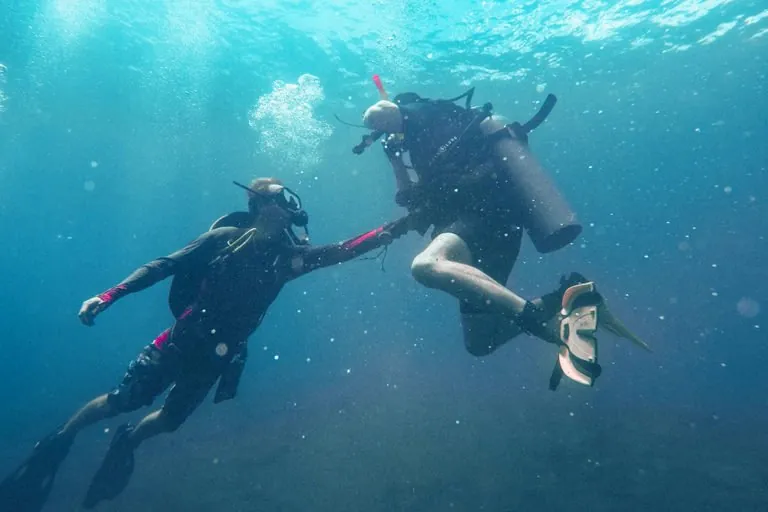Whales Use the Buddy System (and You Should Too)

When it comes to scuba diving, having a buddy is almost as essential as having a tank. Check and check. Not only is it more fun (“hey, did you see that eagle ray?”), but it’s also essential for your safety. If you get lost, anxious, or even have an accident, your diving buddy will be right there to help. In fact, many sea creatures rely on the buddy system, too. (Think Nemo and his anemone.)
FIND YOUR DIVING BUDDY
It’s time to find the sea otter to your kelp forest. Not sure where to start? You can find a dive buddy by booking an excursion with Search Scuba. We’ll make sure that you always have someone to partner with before you take the plunge.
DO THIS BEFORE YOU DIVE
Set Guidelines
Communication is key. Before you dive, make sure that you discuss how long you will be down there and what depth you will you go to. Make sure you both know what route you’ll take and what to do if you end up getting separated.
Decide Your Diving Method
Do you prefer side-by-side diving (like orcas and dolphins) or leading-and-following diving (like barnacles on whales)? Discuss this with your buddy before you dive. If it’s the latter, be sure to establish who is the leader and who is the follower.
Do a Safety Check
Prior to the plunge, check your buddy’s diving equipment (and vice versa). Start with the BCD and weight belt before checking the restraints and air. All set? Do one last final check to be sure.
KEEP CALM AND BUDDY ON
The buddy system exists to keep both parties safe. So if something starts to go awry, here’s how to be the best buddy possible.
Avoid Separation
Getting separated from your buddy is not uncommon. There are many distractions (read: underwater cameras and dive computers) that make it hard to keep a close eye on your buddy. Taking a turn? Be sure to keep your buddy close when changing directions.
If you do get separated, search for one minute before surfacing, as instructed in basic training. If you still cannot find your buddy, you should immediately report it so that there is a rescue team ready.
Stick to Procedure If Your Buddy Panics
Panic. Fear. Anxiety. These are some of the biggest risks when it comes to diving (and they’re the cause of 20% of all scuba-related deaths, according to Scuba Diving Magazine).
If you notice your buddy is panicking here’s how you should proceed:
-
Make eye contact with your buddy. Can’t get their attention? Make the peace sign with your fingers and bring them to your mask, signaling for them to look right at you.
-
Encourage your buddy to breathe. Bring your hand near your mouth and motion in sync with your breaths.
-
Once your buddy calms down, check in and see if they want to continue or end the dive.
Breathe With Your Buddy
If you or your buddy is out of gas, then you will both need to calmly transition to buddy breathing by using the secondary regulator. (Emphasis on calmly).
STAY BUDDY BUDDY
Keep your relationship going outside of diving, as that will only continue to improve your diving experiences.
